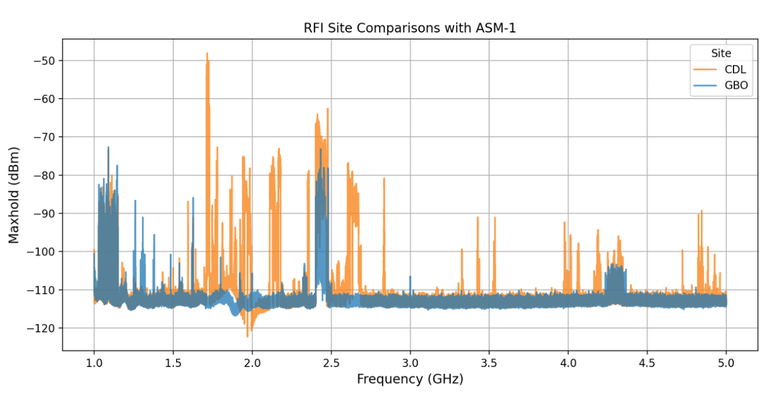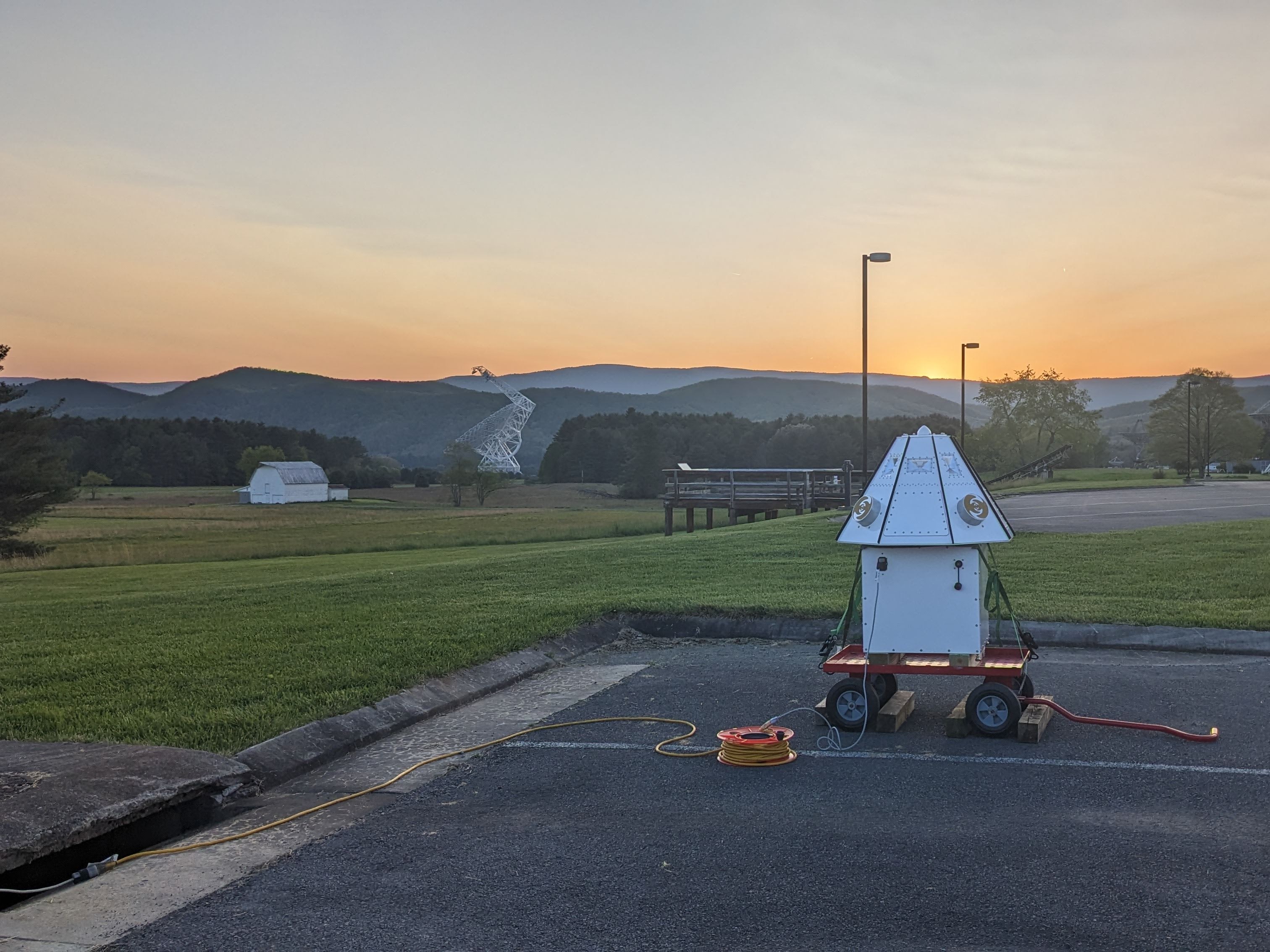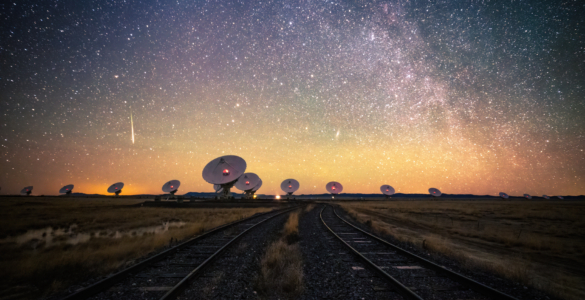What We're Doing
The spectrum is a finite resource, and NRAO is working to make sure that this finite resource is preserved as much as possible for use by passive services like radio astronomy. A passive service is one that does not intentionally transmit radio waves, but only receives them. Spectrum Management at NRAO encompasses five major areas of effort: National Radio Dynamic Zone (NRDZ), National Radio Quiet Zone (NRQZ), Puerto Rico Coordination Zone (PRCZ), Radio Frequency Interference (RFI) Monitoring & Mitigation, and National and International Spectrum Policy. A little more detail about each of these efforts is given below.
National Radio Dynamic Zone
A NRDZ is an idea first proposed less than 10 years ago. It will be a geographical area within our national boundaries that will be a test bed for new technologies and new ways to use spectrum. The hope is that within the boundaries of an eventual NRDZ, innovators will be able to more quickly test new ideas, and that it will enhance the cooperation between active and passive services. The National Spectrum Strategy (NSS), published in Fall 2023 specifically calls for the establishment of an NRDZ. NRAO is working to develop technologies and algorithms that will enable radio astronomers to better understand their local Radio Frequency Interference (RFI) environment, and to more easily coexist with the large and growing number of radio transmitters on the ground and in the sky.
Operational Data Sharing
Low Earth orbit (LEO, orbit altitude around 2,000 km) satellite constellations bring broadband internet and cell phone service to the most remote locations on the planet. Unfortunately, many of those remote locations also host some of the world’s great optical and radio observatories. With the number of LEO satellites expected to increase by an order of magnitude in the upcoming decade, radio frequency interference (RFI) from these satellites is a growing concern in protected radio-quiet areas like the United States National Radio Quiet Zone (NRQZ). When these satellites transmit in the spectrum near a radio astronomy (RA) band, undesired out-of-band emission (OOBE) can leak into the RA band and impact the observations in protected bands.
The National Radio Astronomy Observatory (NRAO) has developed the Operational Data Sharing (ODS) system which publishes radio telescopes’ observation information to a protected database for satellite operators to query through a representational state transfer (REST) API. Satellite operators can use these data to adjust their downlink tasking algorithms in real time to avoid sensitive RA facilities. For more details, see here.
National Radio Quiet Zone
The NRQZ is a geographical region in the Eastern US set aside by the federal government to provide a fixed location to protect sensitive instrumentation from Radio Frequency Interference (RFI). The NRQZ was established by the Federal Communications Commission (FCC) in 1958 to minimize possible harmful interference at both the National Radio Astronomy Observatory (NRAO) in Green Bank, WV and the radio receiving facilities for the United States Navy in Sugar Grove, WV (now Sugar Grove Research Station). The NRQZ encloses a land area of approximately 13,000 square miles near the state border between Virginia and West Virginia, and all fixed radio transmitters in this region are required to coordinate their location, direction and power with the NRAO Zone Regulatory Services office.
Puerto Rico Coordination Zone
The PRCZ consists of islands of Puerto Rico, Desecheo, Mona, Vieques, and Culebra within the Commonwealth of Puerto Rico (the Puerto Rican Islands). Any applicants for fixed or base stations below 15 GHz within this area must correspond directly with the PRCZ Administrator in the NRAO Zone Regulatory Services Office for coordination. This coordination insures that the location of the former Arecibo Observatory remains available for radio astronomical observations.
RFI Monitoring and Mitigation
All Associated Universities, Inc. (AUI) radio astronomy sites (Green Bank Observatory, Jansky Very Large Array and The Atacama Large Millimeter Array) carry out some sort of regular RFI site monitoring, and careful RFI testing of devices to be deployed at any of the sites. RFI is generally a bigger issue at lower frequencies, as many devices emit low frequency electromagnetic radiation, and also because lower frequencies travel (propagate) farther more easily. NRAO has many staff involved in the regular monitoring and archiving of RFI at each site. The current RFI monitoring practices at each site are explained in more detail here. Historical and more current reporting on RFI studies can be found in the NRAO RFI Memo Series. NRAO also holds a monthly RFI Journal club for scientists, engineers, and data analysts.

ESM Policy
The Federal Communications Commission (FCC) administers the spectrum for commercial uses in the US, and is largely responsible for setting national policy on spectrum issues. The FCC also plays a large role in organizing the US national delegation to the International Telecommunications Union (ITU). It is to the FCC that astronomers must generally respond on issues affecting the health of their discipline. ITU-R, the radio bureau of the International Telecommunications Union (a UN agency in Geneva) sets radio telecommunications policy worldwide. Every 3-4 years, a World Radiocommunication Conference (WRC) crafts new treaty language to which member states subsequently adhere by national adoption (with some leeway). For more details on the organizations and agencies that impact spectrum policy nationally and internationally, see here.
WiFi in the “Quiet Zone”
The National Radio Quiet Zone (NRQZ) and West Virginia Radio Astronomy Zone (WVRAZ) were established in the 1950’s in a world very different to the one we now inhabit. There were no cell phones, no smart watches, no electric vehicles, and only a single human-made satellite orbiting planet Earth. Since then, the world has changed in unimaginable ways, and we live in a world filled with radio transmissions across the vast electromagnetic spectrum.
Despite its name, the National Radio Quiet Zone (NRQZ) has never been free of radio transmissions, even from its earliest days: radio broadcasts, emergency services and other essential transmissions have always existed within the 13,000 square miles of the NRQZ. As new technologies are developed (like satellite internet) NRQZ scientists and engineers are working hard to find ways for these technologies to coexist with the NRAO’s scientific mission.
For several years, the Green Bank Elementary and Middle School (GBEMS), located next door to the Green Bank Telescope, has asked the Observatory to find a way to install WIFI for the benefit of teachers, staff, and students.
The Green Bank Observatory and the NRAO Department of Spectrum Management have proposed a path forward for the school, and other residents within the 10-mile radius West Virginia Radio Astronomy Zone, to use WiFi at the specific band of 2.4 GHz. This service will only be operational during the school day at GBEMS so that scientific observations can continue at this frequency at night.
Guidance for local community members to set-up their WiFi at this frequency is available here, and can also be picked up in person at the Green Bank Observatory Science Center.









